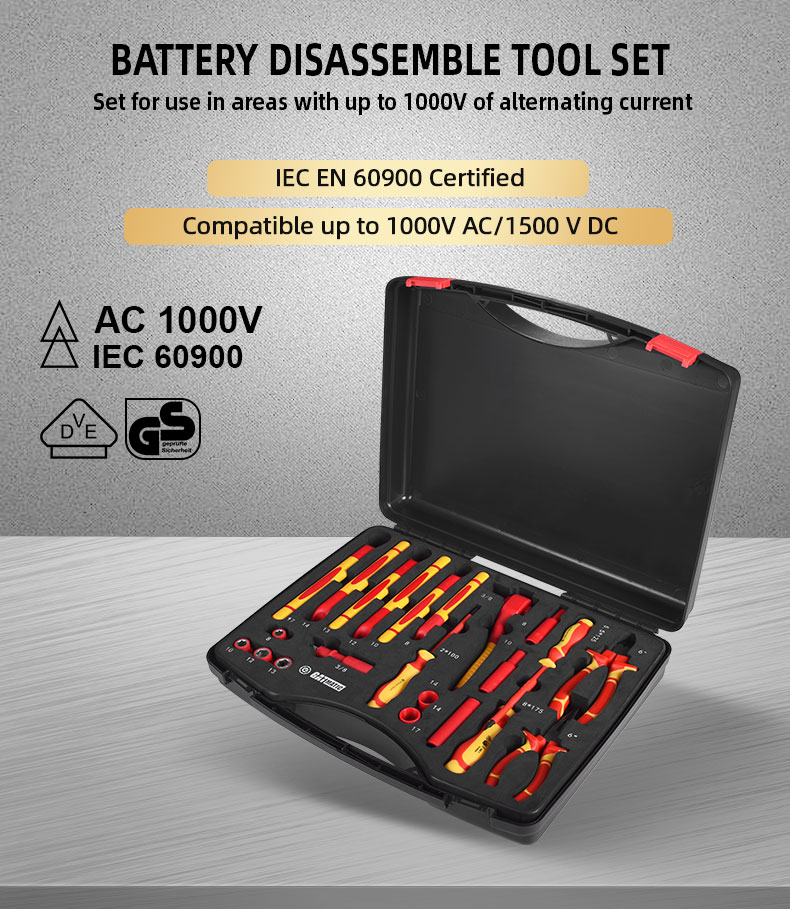Recent Blog
-
What are the limitations of traditional wheel alignment methods?
2024-05-16 -
Is wheel alignment the same as balancing?
2024-05-16 -
How do 3D wheel alignment systems contribute to efficiency and speed in automotive workshops?
2024-05-16 -
Can I use a tool trolley for purposes other than auto repair?
2024-05-07
How often should AC 1000V insulated tool kits be inspected or replaced?
When it comes to electrical work, safety is paramount. One crucial aspect of ensuring safety is the use of insulated tools, especially in environments where working with high voltage is routine. AC 1000V insulated tool kits are designed to protect workers from electrical hazards, but they’re not invincible. Regular inspection and, if necessary, replacement of these tools are essential to maintain their effectiveness and keep workers safe.
I. Understanding Insulated Tool Kits
1. What are AC 1000V insulated tool kits? AC 1000V insulated tool kits are specially designed sets of tools with insulation rated to withstand up to 1000 volts of alternating current (AC). These tools typically include screwdrivers, pliers, wrenches, and other implements commonly used in electrical work. The insulation on these tools acts as a barrier between the user and live electrical components, reducing the risk of electric shock.
2. Importance of insulation in electrical work: Insulation is crucial in electrical work because it prevents the flow of electricity between the tool and the user’s body. Without proper insulation, a tool touching an energized conductor could result in electric shock or even electrocution. Insulated tools provide an extra layer of protection, giving workers peace of mind when working with live circuits.
II. Inspection Frequency
1. Factors influencing inspection frequency: The frequency of inspection for AC 1000V insulated tool kits depends on several factors, including the frequency of use, the severity of the work environment, and the manufacturer’s recommendations. Tools used daily in harsh environments may require more frequent inspection than those used occasionally in controlled conditions.
2. Recommended inspection intervals: As a general rule, AC 1000V insulated tool kits should be inspected at least annually by a qualified technician. However, in high-demand environments or in areas with extreme temperatures or chemical exposure, more frequent inspections may be necessary. Additionally, tools should be inspected before each use for any visible signs of damage.
III. Signs of Wear and Tear
1. Visual indicators of damage: Inspecting insulated tools for signs of wear and tear is essential for identifying potential hazards. Visual indicators of damage may include cracks, cuts, or abrasions in the insulation, as well as looseness or corrosion on metal components. Any damage to the insulation compromises its effectiveness and should be addressed immediately.
2. Testing for insulation integrity: In addition to visual inspection, tools should undergo regular testing to ensure the integrity of the insulation. This can be done using specialized equipment designed to measure insulation resistance. If the insulation resistance falls below acceptable levels, the tool may need to be replaced.
IV. Replacement Considerations
1. When to replace an insulated tool: Insulated tools should be replaced if they show any signs of damage or if they fail insulation resistance testing. Continuing to use damaged or compromised tools puts workers at risk of electric shock and other serious injuries. It’s better to err on the side of caution and replace questionable tools promptly.
2. Importance of proactive maintenance: Proactive maintenance, including regular inspection and replacement of worn or damaged tools, is crucial for ensuring workplace safety. By staying ahead of potential issues, employers can minimize the risk of accidents and protect their workers from harm.
V. Regulatory Compliance
1. OSHA and other safety standards: The Occupational Safety and Health Administration (OSHA) sets forth regulations and guidelines for electrical safety in the workplace. Employers are required to provide a safe working environment for their employees, which includes providing insulated tools where necessary and ensuring they are properly maintained.
2. Legal implications of non-compliance: Failure to comply with OSHA regulations and other safety standards can result in hefty fines and legal consequences for employers. Additionally, workplace accidents resulting from inadequate safety measures can lead to costly litigation and damage to a company’s reputation.
VI. Proper Handling and Storage
1. Tips for extending tool lifespan: Proper handling and storage of insulated tools can extend their lifespan and maintain their effectiveness. Avoid dropping or mishandling tools, as this can cause damage to the insulation. After use, clean tools thoroughly and store them in a dry, temperature-controlled environment away from moisture and extreme temperatures.
2. Best practices for storage and transport: When transporting insulated tools, use protective cases or pouches to prevent damage during transit. Avoid exposing tools to harsh chemicals or environments that could degrade the insulation. By taking these simple precautions, you can prolong the life of your tools and ensure they remain safe to use.
VII. Training and Education
1. Importance of training for tool use: Proper training is essential for ensuring workers know how to use insulated tools safely and effectively. Training should cover proper handling techniques, inspection procedures, and safety protocols for working with live electricity. Investing in employee training can prevent accidents and save lives.
2. Safety protocols for electrical work: In addition to using insulated tools, workers should follow established safety protocols when working with electricity. This includes de-energizing circuits whenever possible, using appropriate personal protective equipment, and following lockout/tagout procedures to prevent accidental energization.
Conclusion
Regular inspection and replacement of AC 1000V insulated tool kits are essential for maintaining workplace safety in environments where electrical work is performed. By following recommended inspection intervals, identifying signs of wear and tear, and promptly replacing damaged tools, employers can protect their workers from the hazards of electrical shock and ensure compliance with safety regulations.
FAQ
1. How do I know if my insulated tools need replacement?
Inspect tools regularly for signs of wear such as cracks, cuts, or faded markings. If any damage is detected, replace the tool immediately.
2. Can I repair damaged insulation on insulated tools?
It’s not recommended to repair damaged insulation as it may compromise the tool’s effectiveness. Replace the tool instead.
3. Are there specific standards for AC 1000V insulated tools?
Yes, several standards, such as those set by OSHA and ANSI, govern the design, testing, and use of insulated tools.
4. Can I use AC 1000V insulated tools for higher voltage applications?
No, it’s essential to use tools rated for the specific voltage to avoid safety hazards.
5. How often should workers receive training on electrical safety?
Workers should undergo regular training on electrical safety protocols, including the proper use and maintenance of insulated tools.
Describe Your Needs In Detail!
We will carefully evaluate your needs and give professional solutions.




